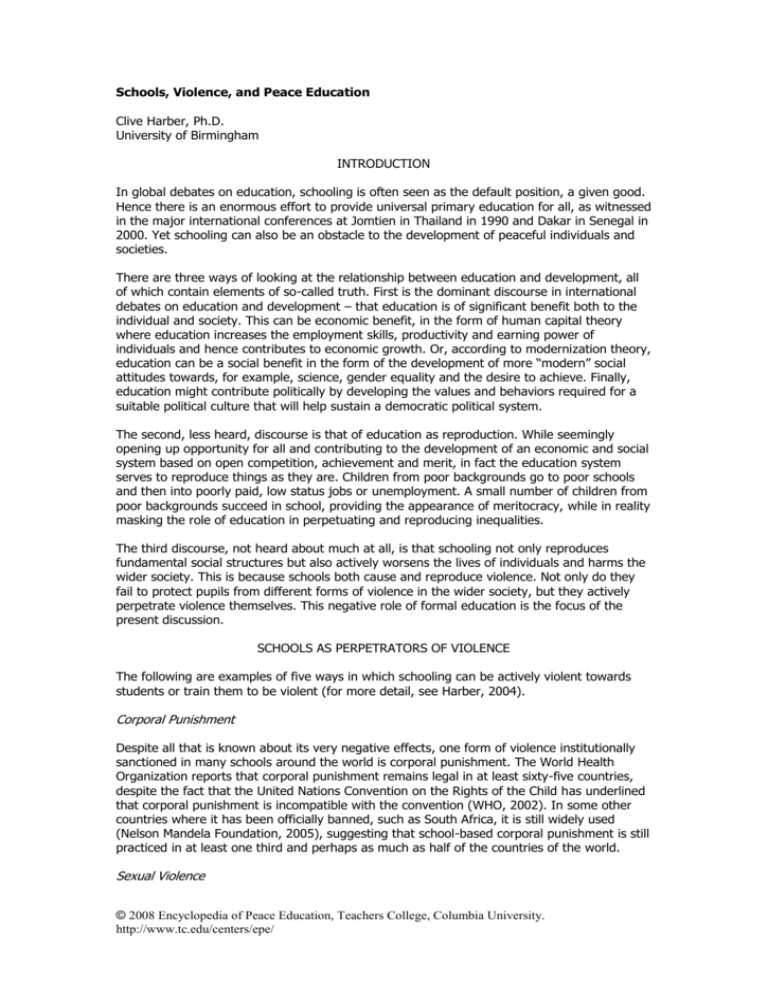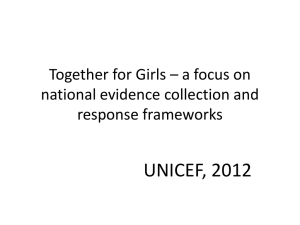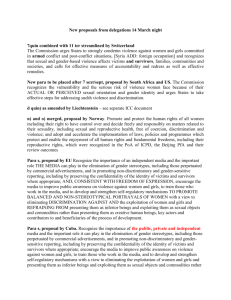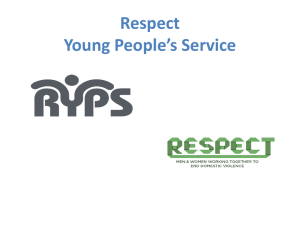Schools, Violence, and Peace Education
advertisement

Schools, Violence, and Peace Education Clive Harber, Ph.D. University of Birmingham INTRODUCTION In global debates on education, schooling is often seen as the default position, a given good. Hence there is an enormous effort to provide universal primary education for all, as witnessed in the major international conferences at Jomtien in Thailand in 1990 and Dakar in Senegal in 2000. Yet schooling can also be an obstacle to the development of peaceful individuals and societies. There are three ways of looking at the relationship between education and development, all of which contain elements of so-called truth. First is the dominant discourse in international debates on education and development – that education is of significant benefit both to the individual and society. This can be economic benefit, in the form of human capital theory where education increases the employment skills, productivity and earning power of individuals and hence contributes to economic growth. Or, according to modernization theory, education can be a social benefit in the form of the development of more “modern” social attitudes towards, for example, science, gender equality and the desire to achieve. Finally, education might contribute politically by developing the values and behaviors required for a suitable political culture that will help sustain a democratic political system. The second, less heard, discourse is that of education as reproduction. While seemingly opening up opportunity for all and contributing to the development of an economic and social system based on open competition, achievement and merit, in fact the education system serves to reproduce things as they are. Children from poor backgrounds go to poor schools and then into poorly paid, low status jobs or unemployment. A small number of children from poor backgrounds succeed in school, providing the appearance of meritocracy, while in reality masking the role of education in perpetuating and reproducing inequalities. The third discourse, not heard about much at all, is that schooling not only reproduces fundamental social structures but also actively worsens the lives of individuals and harms the wider society. This is because schools both cause and reproduce violence. Not only do they fail to protect pupils from different forms of violence in the wider society, but they actively perpetrate violence themselves. This negative role of formal education is the focus of the present discussion. SCHOOLS AS PERPETRATORS OF VIOLENCE The following are examples of five ways in which schooling can be actively violent towards students or train them to be violent (for more detail, see Harber, 2004). Corporal Punishment Despite all that is known about its very negative effects, one form of violence institutionally sanctioned in many schools around the world is corporal punishment. The World Health Organization reports that corporal punishment remains legal in at least sixty-five countries, despite the fact that the United Nations Convention on the Rights of the Child has underlined that corporal punishment is incompatible with the convention (WHO, 2002). In some other countries where it has been officially banned, such as South Africa, it is still widely used (Nelson Mandela Foundation, 2005), suggesting that school-based corporal punishment is still practiced in at least one third and perhaps as much as half of the countries of the world. Sexual Violence © 2008 Encyclopedia of Peace Education, Teachers College, Columbia University. http://www.tc.edu/centers/epe/ 2 The problem of sexual harassment and violence against girls has been neatly summarized in a recent book: Sexual aggression by male teachers and boys is often dismissed as “just boys being boys.” Girls are blamed for “asking for it.” The implicit messages are that males should be tough, assertive, sexually predatory and ready for life in a rough-and-tumble world but females should be delicate, passive, sexually pure and sheltered. These behaviors and messages often make schools un-safe and uncomfortable for girls and are prominent among the reasons why, in many developing countries, adolescent girls are far less likely to attend than adolescent boys (Leach and Mitchell, 2006, p. x). While gender violence in schools is not a problem restricted to developing countries, as Leach and Mitchell note (pp. 26-28), studies have been carried out in at least eight countries in sub-Saharan Africa which have revealed a consistent pattern of sexual abuse and harassment of girls by male students and teachers. Some teachers abused their authority to demand sexual favors from girls in exchange for good grades, preferential treatment in class or money. Such teachers are rarely expelled from the teaching profession, at most being transferred to another school. Similar sexual harassment of female students by their male tutors was found in a study of teacher education in Ghana (Teni-Atinga, 2006). A study of 300 school girls in Pakistan (Brohi and Ajaib, 2006) found that sexual harassment (i.e. comments, lewd suggestions, inappropriate physical contact) was regularly experienced at the secondary level from both male pupils and teachers. The study noted that while the girls were uncomfortable with their experiences, they were also protective of their schools, offering excuses for the transgressions of others because they feared that their families might remove them from school if they knew more about what happened, which according to the authors was a very real possibility. Sometimes sexual harassment becomes even more serious. Estimates for how often a woman is raped in South Africa vary from every 26 seconds to every 90 seconds, and a 1998 Medical Research Council found that 37.7% of South African rape victims who specified their relationship to the perpetrator identified their schoolteacher or principal (Human Rights Watch, 2001, p. 42). Racial Violence In terms of schools deliberately breeding racial and ethnic mistrust and hatred of the “other,” there are a number of well-known examples such as the apartheid education system in South Africa as well as the nationalist systems in Bosnia, Herzegovina and Kosovo, Israel and Palestine, Turkish and Greek Cyprus, and India and Pakistan (Harber 2004:Ch.6; Bayliss 2004). India’s educational system serves as an example of one that perpetrates violence against other groups within the same state. In India, violence against lower-caste people (Dalits) is widespread (Human Rights Watch, 1999). Schooling, however, not only exacerbates prejudice against lower-caste people, it also acts in a directly violent way towards them. The caste designation of “untouchable” was abolished in 1950, but the country’s 200 million Dalits, now referred to as “scheduled castes” or “scheduled tribes,” still routinely suffer from discrimination. A national report in 2002 found that many lower-caste children are regularly beaten at school by teachers who consider them to be “polluting” the class. Additionally, the India Education Report compiled by the National Institute of Educational Planning and Administration noted that lower-caste pupils were regularly verbally and physically abused: punished at the slightest pretext, often humiliated, and made to sit and eat separately. Higher-caste teachers refused to touch the exercise books or writing slates of lower-caste children, and they were made to sit on their own mats outside the classroom or at the door. Additionally, many lower-caste children are not allowed 3 to walk through the village on their way to school and are denied their right to free textbooks, uniforms and a midday meal (Behal, 2002). Examinations In some societies there is a cultural tradition of fierce competition within schooling that has been exacerbated by neo-liberal market reforms. In developing countries, the competition for scarce places in secondary and higher education, with their assumed links to the middle and upper levels of the labor market, has become exaggerated by cutbacks in the public provision of education as a result of poor economic performance and World Bank-imposed structural adjustment programs based on neo-liberal economics (Samoff 1994, IJED 1996). Schooling is now therefore even more of a competitive assessment and serves as a selection mechanism with ‘winners’ and ‘losers’ at all levels. The consequences of this can be very stressful for students. In 2003 in Egypt, for example, poor results on the final secondary school exam caused a spate of suicides. At least nine adolescents killed themselves, either in anticipation or as a result of low scores on the exam that determines university admission. Because of Egypt’s growing population and widespread unemployment, a university degree is viewed by many young Egyptians as the only guarantee of future stability, and middle-class families spend a great deal of money on tutors (Lindsey, 2003). Schoolchildren in Britain are also heavily tested, not primarily for diagnostic reasons but so that schools can be compared and ranked and parents can make informed decisions in the educational marketplace. What is the result of all this testing on British children? One survey of more than 8,000 secondary school pupils in England and Wales in 2000 led to a report entitled Tested to Destruction. The report claimed that stress caused by examinations is damaging the physical and emotional well-being of the nation’s teenagers. Physical symptoms included difficulty sleeping as well as eating disorders including bulimia and anorexia. A cartoon attached to the article describing the survey depicts a child returning home from school and saying to her mother, “We had a lesson in the break between tests today” (Smithers, 2000). SCHOOLS AND MILITARY TRAINING A key role of the state is to defend its borders, requiring the loyalty of its population. School systems are used by states for purposes of political socialization and indoctrination, and one aspect of this is to create loyalty to the state by encouraging not only obedience and a respect for the authority of the state (or a particular regime), but patriotism and a proclivity to fight for one’s country (often portrayed as coterminous with a particular ideology or regime). Thus, in some nations such as Prussia/Germany (Green, 1990, pp. 32,130) and Japan (Shipman, 1971, chapter 9), there is a strong historical relationship between schools and the military. In a number of countries, military training has been introduced as part of the school curriculum. In Venezuela, President Chavez decreed in 1999 that all school children would be given military training. The President, a former paratrooper, ruled that all children in the 2,200 primary and secondary schools must be given lessons in military strategy, weapons handling and national sovereignty issues. President Chavez, who was himself educated in military schools, first announced the militarization of schools during a four-hour speech to Venezuela’s teachers’ union. He received a standing ovation when he said that military training would make Venezuela more efficient (Gamini, 1999). In 2000, it was announced in Russia that teenage girls were to be offered military training as part of the school curriculum in the same way as boys. Those girls who receive military training will be listed in the military reserves and will be liable to deployment in times of war. Full combat training would be included, as would military theory and practice on the firing 4 range. The extension of military training in schools would allow girls to compete with boys for officer training places at elite military academies, opening up avenues for promotion in the armed services (Louis 2000). As recently as 1999, in parts of Cambodia still controlled by the Khmer Rouge, children were being taught how to lay landmines, how to set booby traps, how to make weapons from fertilizer and how to transport weapons to the guerrilla fighters on the front lines (Warren, 2002). In the United States, John Ashcroft, the Attorney General of the first Bush Administration, has been linked to a pro-gun lobbying group that believes that the answer to America’s school shootings is to allow pupils to be armed in the classroom (Kettle and Martinson 2001). WHAT ABOUT ISRAEL? AUTHORITARIAN SCHOOLING What is it about the nature of schooling that allows it to actively perpetrate violence? Overwhelming evidence shows that the dominant global model, with some exceptions, is authoritarian rather than democratic (Harber, 2004). Education for and about democracy, human rights, critical awareness and peace is not commonly found in the majority of school systems. While the degree of despotism within authoritarian schools varies from context to context and from institution to institution, in the majority of schools, power over what is taught and learned, how, where and when it is taught and learned, and what the learning environment is like, is not in the hands of pupils. Government officials, head teachers, and teachers predominantly make those decisions, not learners. Most schools are essentially authoritarian institutions, however benevolent or benign that authoritarianism may be, and whatever beneficial aspects of learning are imparted. In situations of relative powerlessness and neglect of basic human rights, pupils can be mistreated violently or influenced by potentially violent beliefs because the dominant norms and behaviors of the wider society are shared, not challenged, by many adults in the formal education system. Why are most international formal institutions of learning socially constructed in this way? Throughout the history of schooling, there has always been a conflict between education for control—in order to produce citizens and workers who are conformist, passive and politically docile—on the one hand, and education for critical consciousness, individual liberation and participatory democracy, on the other. It is my contention that the former model has dominated the real world of schooling because this was the main reason that formal, mass educational systems were established in the first place and then expanded numerically and geographically. Some educational writers, practitioners and policy makers have championed the latter approach to schooling and education in general, but the global persistence of the dominant authoritarian model suggests that the original purpose of control and compliance is deeply embedded in schooling and highly resistant to change as a result. CONCLUSION For this writer, the twin fundamental goals of education should be both peace and democracy, which in my view cannot be separated. The achievement of more peaceful societies also requires the institutionalization of greater levels of democracy than is currently the case globally. Democracy provides the best political environment available for the peaceful solution of disputes and conflicts. Authoritarian regimes, usually military or single party, are often plagued by civil unrest, violent repression and resistance, over-high levels of military expenditure, and wars with neighboring regimes. While democracies are far from being perfect, accountable and representative governments tend to minimize internal violence and greatly decrease the possibility of going to war without good reason, although this is by no means guaranteed. At the micro-level of social institutions, such as the workplace or the school, democratic organization tends to emphasize peaceful solutions to problems and disagreements through discussion and participation rather than imposition, confrontation, conflict and violence. 5 However, democracy is not possible without democrats. Democracy is only sustainable in a supportive political culture where a sufficient proportion of the population have a high commitment to democratic values, skills and, particularly, behaviours. This is based on an understanding of democracy that goes beyond the minimum ritual of voting (or not voting) every four or five years in an election. While democracy does require an informed citizenry capable of making genuine political choices, it also requires a fuller and deeper notion of democracy that forms the basis of a democratic society in which people actually behave in a democratic manner in their daily interactions, including the peaceful management and resolution of conflict. REFERENCES Bayliss, S. (2004). Fairytale texts breed hatred. Times Educational Supplement, 14/5. Behal, S. (2000). Exam stress prompts reform demand. Times Educational Supplement, 21/7. Brohi, N. and Ajaib, A. (2006). Violence against girls in the education system of Pakistan. In F. Leach, and C. Mitchell (Eds.), Combating gender violence in and around schools. Stoke On Trent, UK: Trentham Books. Gamini, G. (1999). Guns in school draw ovation. Times Educational Supplement, 9/7. Green, A. (1990). Education and state formation. London, UK: Macmillan. Harber, C. (2004). Schooling as violence. London, UK: RoutledgeFalmer. Human Rights Watch. (1999). Broken people: Caste violence against India’s “untouchables.” New York, NY. Human Rights Watch. (2001). Scared at school: Sexual violence against girls in South African schools. New York, NY. IJED. (1996). Special edition on the World Bank and structural adjustment. International Journal of Educational Development. Kettle, M. and Martinson, J. (2001). Bush’s choice linked to “Guns for Pupils.” group. The Guardian, 13/1. Leach, F. and Mitchell, C. (Eds.). (2006). Combating gender violence in and around schools. Stoke On Trent, UK: Trentham Books. Lindsey, U. (2003). Spate of suicides sparks call to ease exam pressure. Times Educational Supplement, 15/8. Louis, J. (2000). Russia lets slip the girls of war. Times Educational Supplement, 11/2. Nelson Mandela Foundation. (2005). Emerging voices. Cape Town, South Africa: HSRC Press. Samoff, J. (1994). Coping with crisis: Austerity, adjustment and human resources. London, UK: Cassell. Shipman, M. (1971). Education and modernisation. London, UK: Faber. Smithers, R. (2000). Exams regime harms pupils. The Guardian 4/8. 6 Tengi-Atinga,G. (2006). Ghanaian trainee teachers’ narratives of sexual harassment: A study of institutional practices. In F. Leach, and C. Mitchell (Eds.), Combating gender violence in and around schools. Stoke On Trent, UK: Trentham Books. Warren, M. (2002). After the terror. Times Educational Supplement, 4/1. World Health Organisation. (2002). World report on violence and health. Geneva, Switzerland: WHO.








